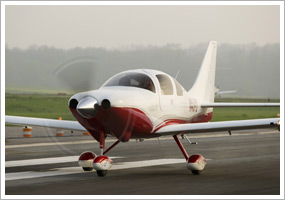| The following stories from the Aug. 12, 2011, edition of AOPA ePilot were provided to AOPA members who expressed an interest in the particular subject areas. Any AOPA member can receive information tailored to their areas of interest by updating their preferences online |
training tips‘The runway behind you’ It’s even worse if your own technique was responsible for the runway being where you can’t use it. For takeoffs, the economical choice is also the safe choice: Don’t waste runway! Many pilots routinely squander surface for no good reason. Complacency is often the culprit. Unlike short-field departures, normal takeoffs place no special emphasis on using all available runway. Bad habits result. Lining up for takeoff, many pilots let the aircraft creep forward—sometimes, well forward—while they fiddle with dials or knobs. Following the leisurely alignment, the pilot only gradually powers up for takeoff as the aircraft rolls along, gobbling precious runway. A better approach is to find a way to use maximum available takeoff area under all takeoff circumstances—especially under high-density-altitude conditions or when you must make an intersection takeoff. How much runway is actually available for takeoff? Check runway-distance-remaining signs. Remember, when taking off from a runway with a displaced threshold, that the displacement reduces runway available for landing—but not for the takeoff. Know your aircraft’s takeoff performance, and always build in a healthy margin of error. Attention to small details can pay large dividends. That’s what pilots practicing max-performance takeoffs and landings on just a few hundred feet of gravel are safely learning this summer under a program in Alaska. Follow up your runway-conserving takeoff with a disciplined climb at best-rate-of-climb speed (V Y) to a safe maneuvering altitude. Focus on applying the private pilot practical test standard of maintaining airspeed of V Y plus 10 knots or minus 5 knots to your climb. As for that old saying about the three most useless things for a pilot: It has many variations. Musician Aaron Tippin offered one arrangement, giving some advice to student pilots in the January 2011 Flight Training’s “Debrief” column. Learn the lyrics, and stay safe! training productsVOR-At-A-Glance flash cards from Aircraft SpruceVOR: the navigational aid that everybody loves to hate. Whether you’re trying to master them or studying for a knowledge test or checkride, you must understand how to interpret them. VOR-At-A-Glance flash cards from Aircraft Spruce will help you to read course, radial, and location information at once. The retail price is $36.75. Order online or call 877/477-7823.
Note: Products listed have not been evaluated by ePilot editors unless otherwise noted. AOPA assumes no responsibility for products or services listed or for claims or actions by manufacturers or vendors. final exam
Question: I’m based at a nontowered airport and I’d like to know the difference between the departure leg and the upwind leg.
Answer: The Aeronautical Information Manual addresses this question in Chapter 4, Section 3, Airport Operations. The upwind leg runs “…parallel to the landing runway in the same direction of landing. The departure leg begins after takeoff and continues straight ahead along the extended runway centerline.” So the main difference between the two is that the upwind leg is parallel to the runway whereas the departure leg is along the extended runway centerline. For more information on flying at nontowered airports, see the Air Safety Institute Safety Advisor Operations at Nontowered Airports .
Got a question for our technical services staff? E-mail [email protected] or call the Pilot Information Center, 800/872-2672. Don’t forget the online archive of “Final Exam” questions and answers, searchable by keyword or topic. |
 An old saying reminds pilots that one of three things of no use to a pilot is “the runway behind you.”
An old saying reminds pilots that one of three things of no use to a pilot is “the runway behind you.”